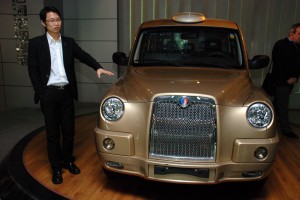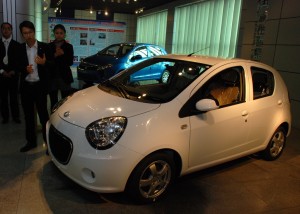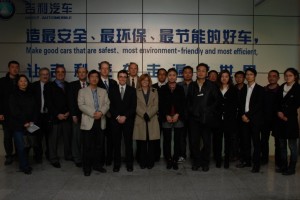Seeing a Chinese Auto Plant; Kicking the Tires
Growing up as a teenager in Indiana about 35 years ago, I remember when Japanese automakers began to gain a foothold in the U.S. market. The cars were smaller, boasted fewer features and much higher fuel economy, which recently became more important due to the OPEC Oil Crisis.
In the years to come, many Americans embraced the now familiar brands of Honda, Toyota and Nissan, which have since located production facilities in the United States and created a vast supplier network here as well. America’s Big Three automakers found them to be solid competitors.
On Tuesday, our delegation visited the production facilities for Geely, one of several China-based automakers, in Ningbo City, located along the coast about two hours from Hangzhou.
The company, China’s second-largest car maker, was founded 25 years ago (It started out in 1986 as refrigerator parts manufacturer), now has nine auto production facilities across the country. It also makes cars in the Ukraine, Russia, Indonesia and Malaysia and boasted an overall tally of 410,000 cars sold worldwide in 2010.
Although Geely is a decidedly Chinese company, its vehicles feature parts made by Siemens, Bosch and Lear. Its top seller, the Cruise, was designed completely in Korea, and is sold in 50 countries. One of its newest models, the Englon, was designed in Italy.
It recently acquired a 20 percent stake in Manganese Bronze, the makers of London’s taxis. Last August, it acquired the popular Swedish brand, Volvo, but so far hasn’t started to produce the cars in China.
The electric version of Geely’s Panda subcompact is only sold in Taiwan (It’s perfect for an island country, since it only goes little over 100 miles per charge).
But it appears unlikely that Geely will present a new threat to the Big Three for a while. This company and China’s other automakers face much competition from car companies from outside the country.
While you find many Japanese cars on the highway, you’re more likely to see Volkswagens, Audis, Hyundais and BMWs. For the very rich, we saw dealerships for Bentley, Lamborghini and Rolls Royce.
A couple of our guides told us that many Chinese people haven’t overcome entrenched feelings about Japan going back decades, if not centuries. They also are hesitant to buy their own brands because of quality concerns.
This brings us back to the Big Three. General Motors has been here for decades .According to Professor Scott Kennedy, GM has successfully become integrated into the economy here and has been effective in setting up the needed supply chain.
So much so that GM gets treated in many ways like a domestic company, he said.
Buick, a brand that practically disappeared in the U.S., has found its largest market in China.
Touring the Geely facilty, we observed mostly youthful employees who appeared to be closer in age to many IU students. Our guide there told us that the average age of the 3,000 employees there was 28 years old, including people in management.
Most workers make about 3,000 RMB each month and work eight hours a day, six days a week, she said.
The least expensive Geely automobile costs about 50,000 RMB. Even with a 10 percent employee discount, it’s unlikely that many of the workers – many of whom have come from other places in China to work there – will be able to afford the product they’re producing.
Our college-educated interpreter now makes about 8,000 RMB, but soon will make about 6,000 RMB if he takes a job as a sales agent. He’s much more likely to buy a car, but he doubts he wants a Chinese brand.
Here is Geely’s approach to doing business, as expressed in large letters inside the factory as well as outside: “Discovering the problem is good, solving the problem is important, avoiding the problem is stupid, so no problem is bad.”
On Thursday, we toured GM’s facilities. Government stimulus efforts to encourage people to buy cars have been especially helpful to the American automaker, which I’ll write about in an upcoming post.
No Comments
No comments. Be the first.
Sorry, the comment form is closed at this time.




